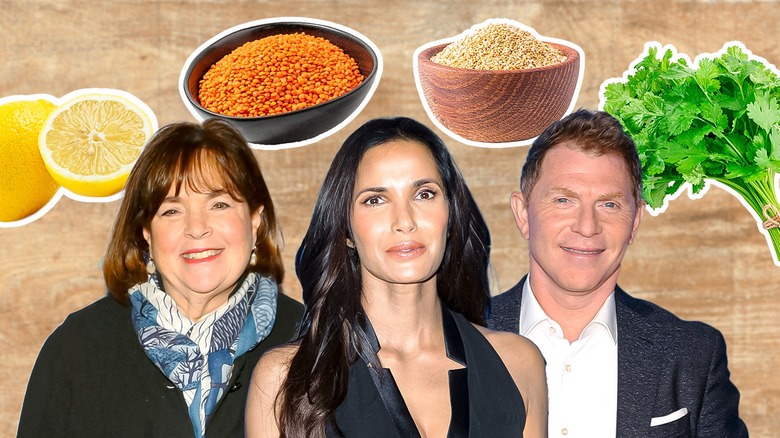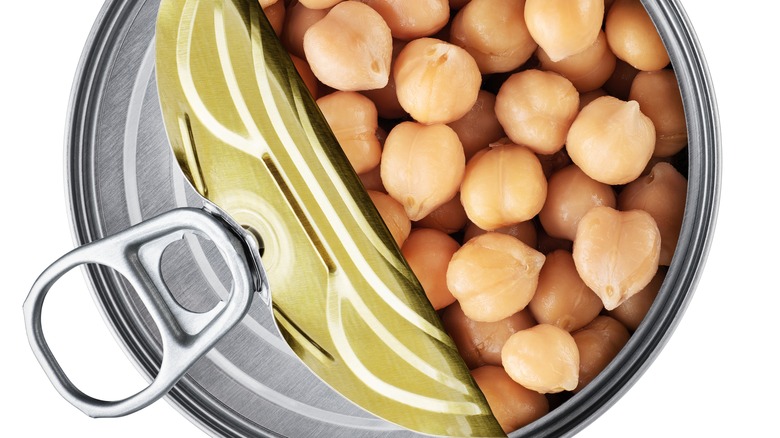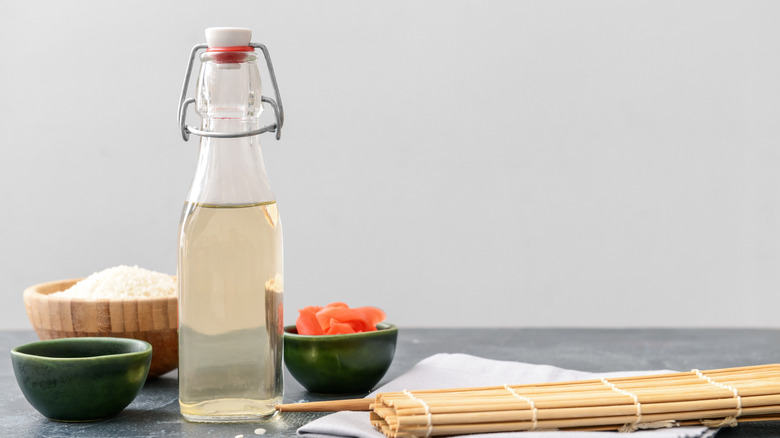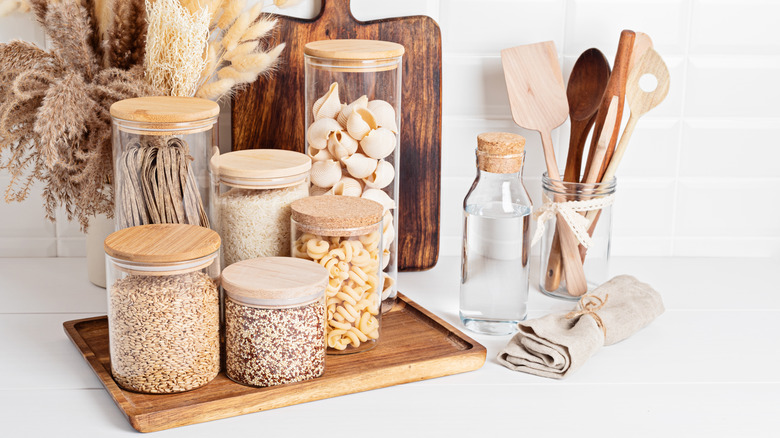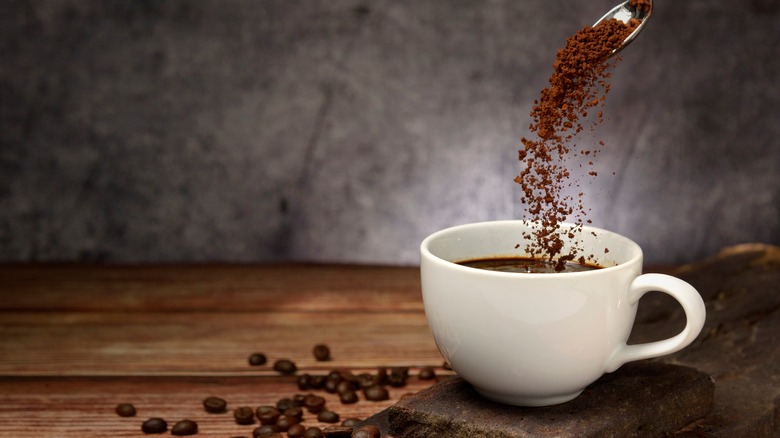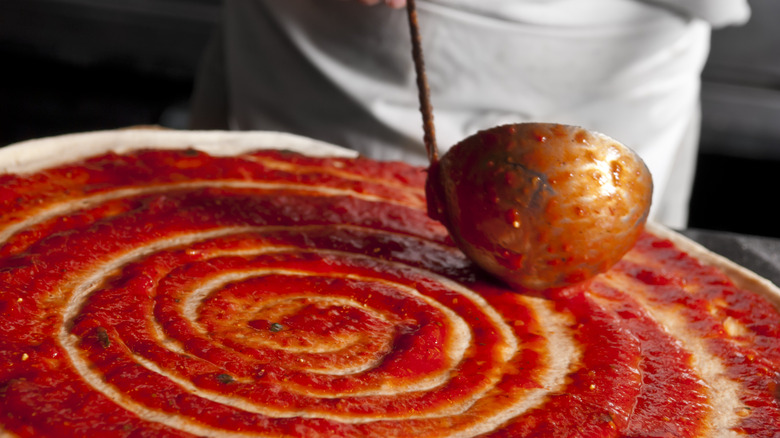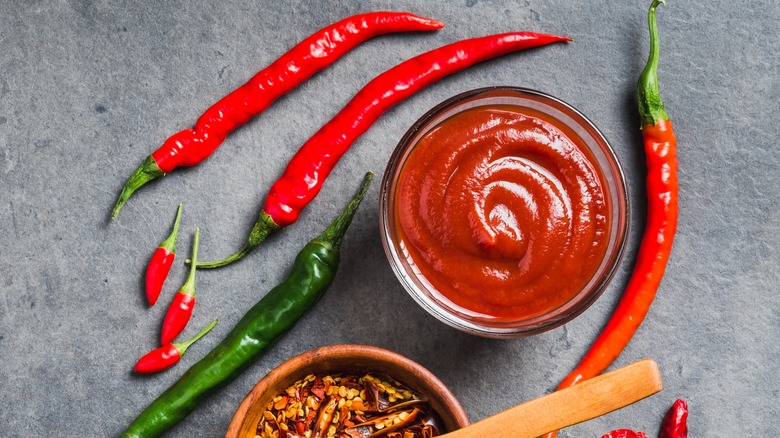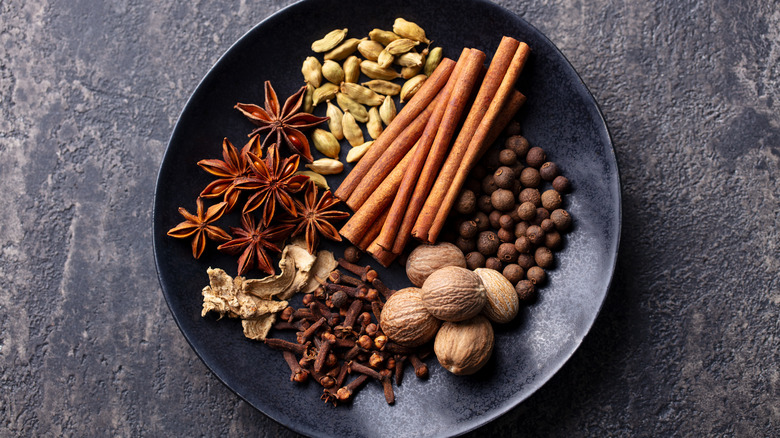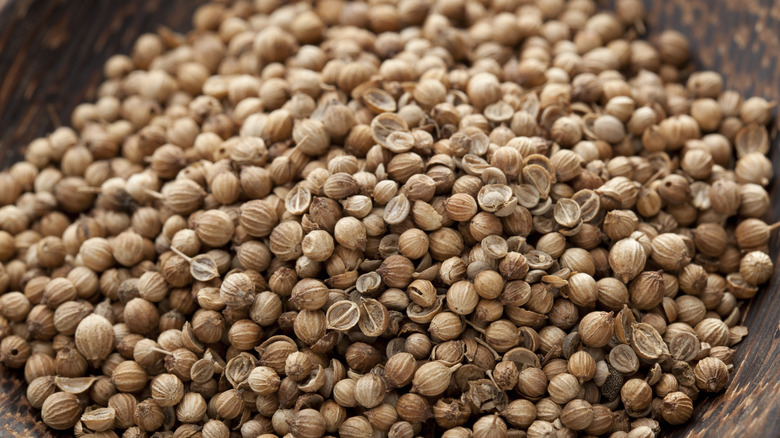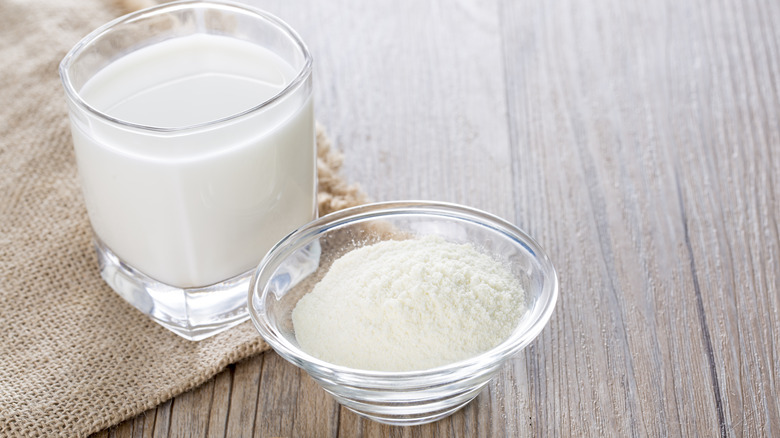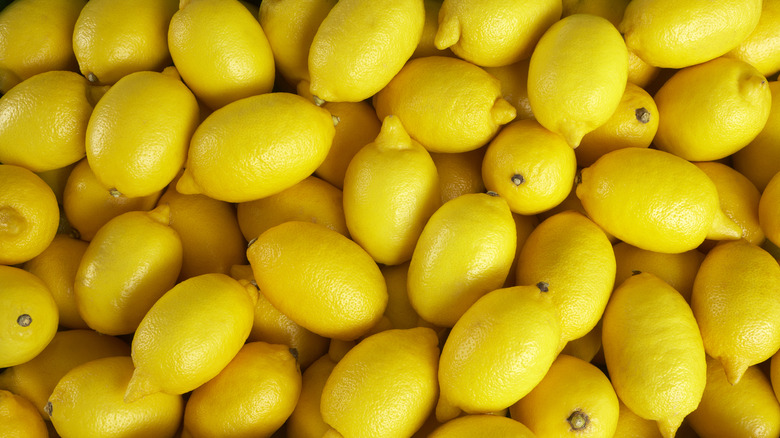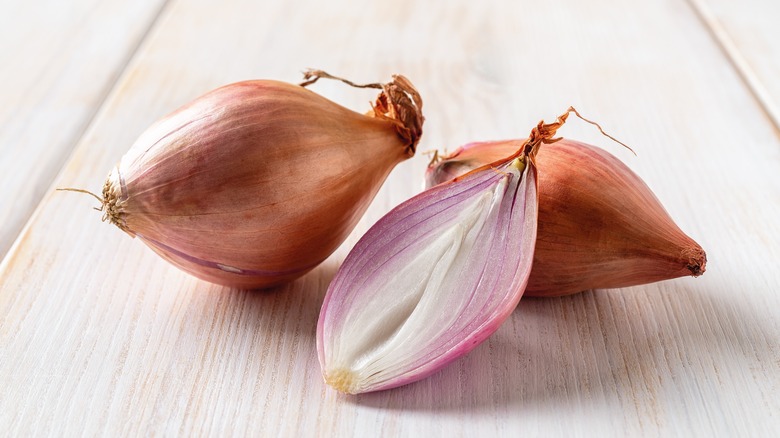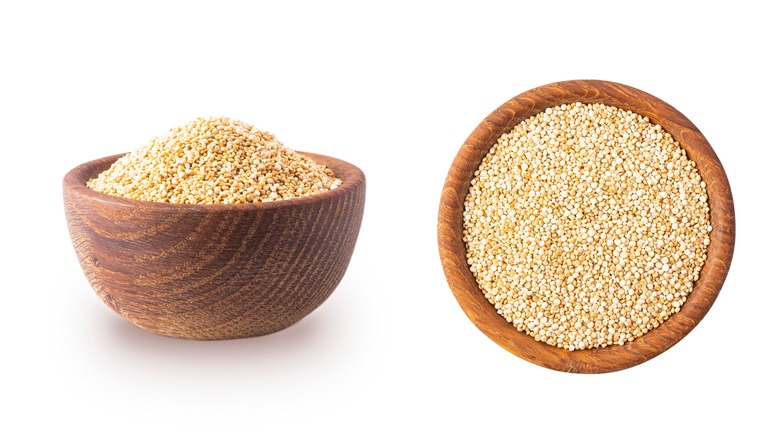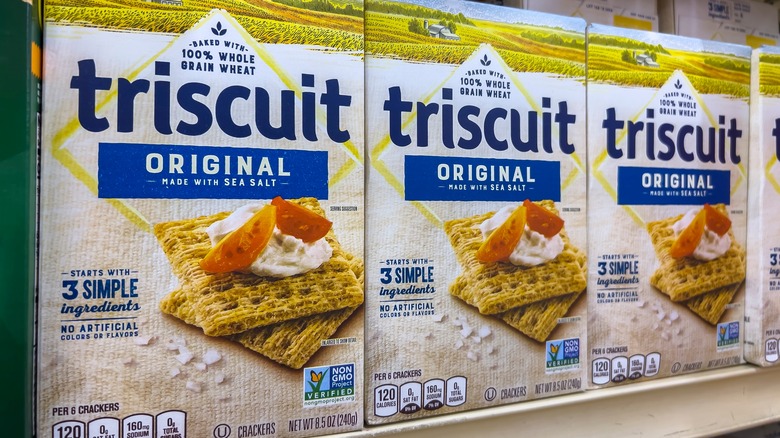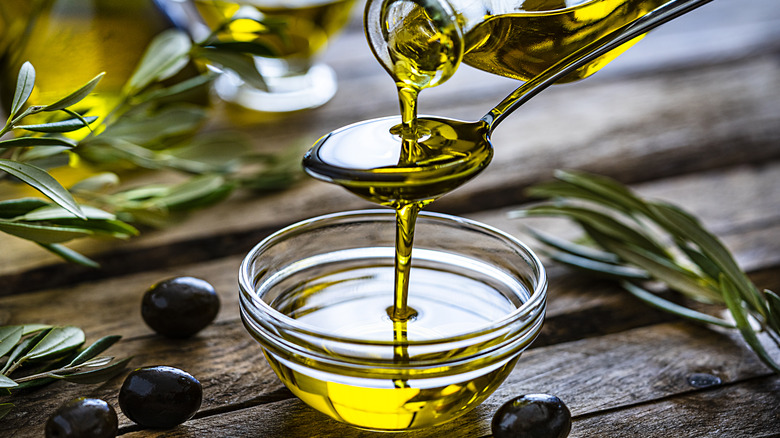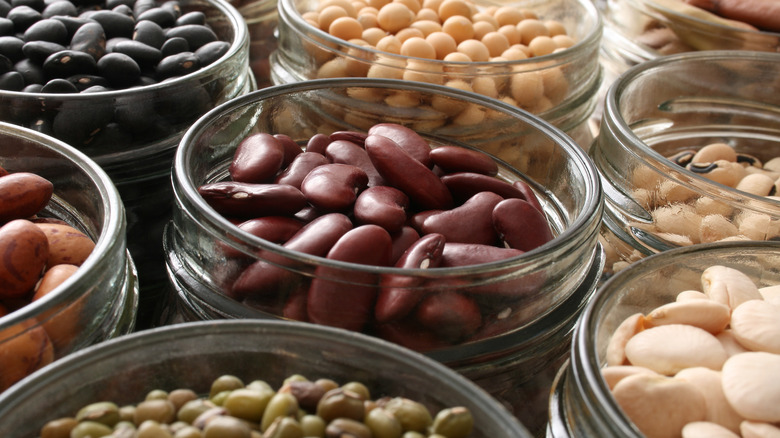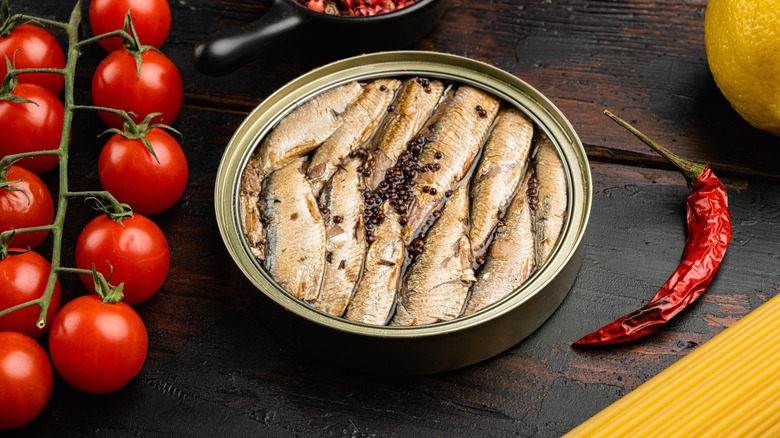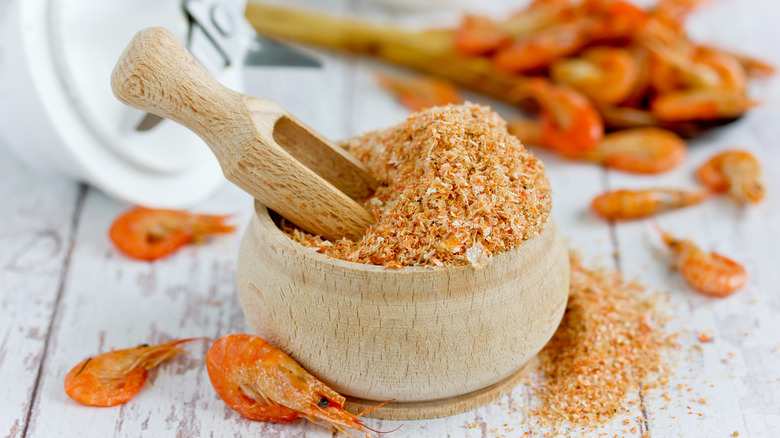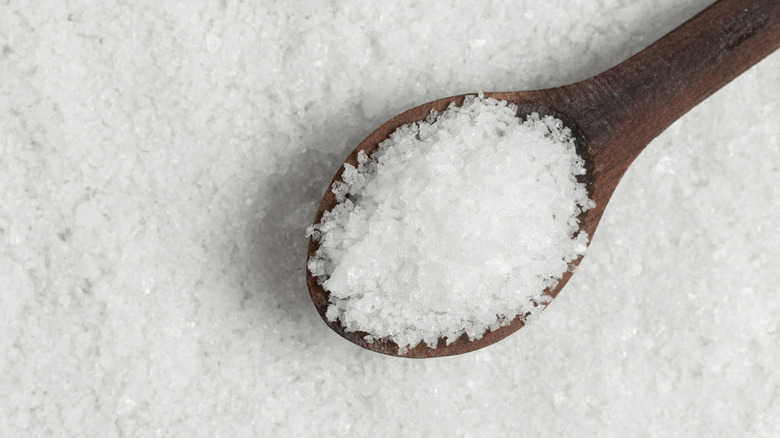18 Essential Ingredients Celebrity Chefs Keep In Their Pantry
A well-stocked pantry is the foundation of a well-oiled kitchen, providing a world of flavors and endless possibilities for inspired cooking. Whether you're a seasoned chef or a budding home cook, the importance of maintaining a curated pantry cannot be overstated. If you've ever whipped up a half-decent meal in 20 minutes on a weeknight, then you know this to be true.
That's because aside from the convenience of having a wide range of ingredients on hand, a diverse pantry can unlock doors to various cuisines and culinary traditions. A touch of cinnamon can elevate a bland breakfast oatmeal, while a jar of marinara sauce can be the base for a fantastic pasta dish. A pantry thus becomes more than a place in which to store your non-perishables. It's a passport to a world of flavor combinations you haven't even discovered yet. Also, stocking your pantry with pasta and rice can help you put together a last-minute meal for unexpected visitors or lazy, rainy nights when going to the store seems like just too much. So let's look at the essential ingredients you'll need in your pantry to be prepared for any eventuality.
1. Canned or dried pulses
Alex Guarnaschelli of "Chopped" always furnishes her pantry with a stock of pulses like lentils, beans, and chickpeas, either in canned or dried form. The beauty of these ingredients is that they have a long shelf life, can be used to feed large groups, and lend themselves well to a wide variety of recipes, from pastas to chilis and even salads.
They're also highly nutritious, packing a good amount of fiber and protein in those tiny little nuggets, according to the Harvard School of Public Health. And don't forget to mash up your canned chickpeas for the occasional hummus snack. Just blitz a can of chickpeas in your food processor with some tahini, lemon juice, olive oil, and salt, then dust the top with some paprika, extra olive oil, and extra chickpeas.
2. Rice vinegar
All Omi Hopper of Next Level Chef needs to spruce up one of her steak dishes is a bit of rice vinegar. This Puerto Rican chef swears by this ingredient especially when making onion steaks, like the notable Puerto Rican dish known as bistec encebollado, which is marinated in onions and vinegar before being combined with a tomato-based sauce. Instead of using regular vinegar, Hopper opts for rice vinegar, which makes the dish a bit sweeter.
Another use for rice vinegar includes sushi, which is short-grain rice mixed with a mild white rice vinegar. Meanwhile, brown rice vinegar, made from fermented brown rice, is milder and nuttier than other vinegars, making it an ideal choice for a subtle salad dressing or a dipping sauce.
3. Rice and pasta
Bobby Flay somehow knows that on some evenings, you don't want to change out of your pajamas and go to the grocery store. He suggests that everyone have at least a few boxes of pasta and rice in the pantry at all times. These elements are so basic and versatile that they can be made into virtually anything. If you're up for it, they can even be eaten on their own with a bit of oil or butter.
But you don't have to make it bland. The thing about rice and pasta is that you can cook them with almost any other ingredients you have in your pantry and they're going to come out just fine. One example is the famous Italian dish aglio olio e peperoncino, which means garlic, oil, and hot pepper. Just boil some spaghetti while toasting crushed chiles, breadcrumbs, and garlic, then combine the drained pasta with the rest of the ingredients, reserving a bit of pasta water for the sauce.
4. Instant coffee granules
When we think of pantry ingredients, we often think about how we can use them to make a full meal. But that would be doing a disservice to the world of desserts. Haven't we all had that craving for late-night chocolate chip cookies? With the right pantry ingredients, we can whip them up at home, at the drop of a hat.
To that end, Ina Garten wants us to make sure we always have instant coffee granules in our pantries. If you're making a chocolate-based dessert, like a chocolate mocha cake, you're going to need them to bring out the chocolate flavor even more. Ina Garten also loves to add coffee to any cookies containing chocolate. The important thing to remember here, in terms of saving time, is that instant coffee granules will dissolve much more easily in your batter, so they're a great option for a quick cookie recipe without too much fanfare.
5. Marinara sauce
Ina Garten also suggests keeping a good jar of marinara sauce in your pantry, because life isn't just about desserts, unfortunately. Although she prefers Rao's, you can select your favorite brand and half the prep time for dishes such as lasagna or eggplant parmesan. The sauce is often the part that takes the longest, so, you're welcome.
But you don't have to stop there. Your favorite marinara sauce can be plopped straight onto your homemade pizza dough, right before you add your mozzarella and stick it all in the oven. Jarred marinara sauce can also become the base for a lovely pasta sauce, or you can pour it into your meat sauce when making this 30-minute Bolognese instead of the can of crushed tomatoes.
6. Calabrian chili paste
Although Giada de Laurentiis needs at least five key ingredients in her pantry at all times, including pasta, arborio rice, jarred tomato sauce, and olive oil, one item, in particular, stands out, and it's not necessarily something other celebrity chefs have suggested already. This ingredient is Calabrian chili paste, which de Laurentiis uses liberally throughout her cooking, including in pasta sauces, stews, and salad dressings.
Although this particular paste is Italian, it doesn't have to be limited to Italian dishes. You can also use it as a topping for your morning eggs, or you can mix it into your meatloaf along with the ketchup. You can also stir it into your soup for a quick and easy way to add extra warmth on a cold night.
7. A set of warm spices
If you don't have salt and pepper in your pantry, you're off to a bad start. There are very few recipes that can be made tasty without the addition of some salt somewhere along the road. Likewise, a dash of pepper on top of your prepared meal brings out the flavor like no other spice. This is why Gordon Ramsay recommends always having sea salt and black peppercorns on hand.
But he doesn't stop there. Ramsay also thinks everyone should have a set of warm spices like cinnamon, cloves, cardamom, and nutmeg. All of these can be used in both sweet and savory dishes, and a little bit of them goes a long way. You will also likely need to reach for chili powder and paprika pretty regularly, while turmeric, coriander, and powdered ginger are not unusual ingredients in Indian or East Asian recipes. But what it comes down to, are the recipes you turn to time and time again. Make sure you have spices from those recipes on hand, and that you replace them at least once a year to make sure they're fresh.
8. Coriander
Based on Padma Lakshmi's (of "Top Chef" fame) pantry recommendation, she couldn't agree more with Gordon Ramsay. She also suggests keeping a bevy of diverse spices in your pantry, but in particular, she singles out coriander, a citrusy spice that comes in the form of small, round seeds. It can be used in both sweet and savory dishes, and in both cases, toasting the seeds first will help bring out its subtle flavor.
In fact, the key seems to be to stock the pantry with unusual herbs and spices like sumac, which is made by grinding down the berries of the sumac tree, or za'atar, a Middle Eastern blend of thyme, oregano, salt, toasted sesame seeds, and, incidentally, ground sumac. These unusual spices will give you the opportunity to play around with different flavors and cuisines, unleashing your creative side.
9. Powdered milk
According to CheatSheet, "Great British Baking Show" winner Nadiya Hussain knows how to make a fine hot chocolate, among many other things. And the best part is that you can still make her recipe even if you've run out of whole milk, as long as you keep a generous stock of powdered milk in your pantry.
Milk is one of those ingredients that seems to fly off the fridge shelf, especially if you have a big family. It's used for breakfast cereals, morning coffee, and there's always that growing teen rummaging through the fridge and settling on a helping of milk directly out of the carton. But not to worry. If you follow the instructions on the packet and get your powder-to-water ratio right, powdered milk will yield a nice, creamy mixture to add to your hot chocolate that works just as well as the real stuff.
10. Lemons
Lemons may not last as long as a can of beans, but they're likely to hold for over a week at room temperature and up to a month in the fridge. And Queer Eye's Antoni Porowski thinks it's worth it, at least according to what he told Variety, when he said he puts "lemon zest literally in 99.9% of everything that I make."
And maybe you haven't noticed the opportunities yet, but you could be doing the very same thing. Aside from lemon-forward dishes like this lemon-glazed pound cake or this roasted lemon chicken recipe, freshly-squeezed lemon can be used to add a burst of flavor to almost any prepared dish, whether it be fish, pork, or a salad. And don't forget to use a twisted slice of zest for your Martini garnish.
11. Shallots
Michelle Bernsteain of Cafe la Trova told Food and Wine that she doesn't "know how to start a recipe without them." She was talking about shallots, which look like small onions and taste like sweet versions of their larger cousins. And she's quite right. Shallots work exceedingly well in a wide range of savory dishes, from salad dressings to meat sauces, and they're quick and easy to chop up and toss in whatever's cooking in the pan.
One great way to use them is in this classic shallot mignonette recipe. All you'll need are a couple of shallots, some red wine vinegar, and freshly ground pepper — all of which should be pantry staples of yours. Then dice your shallots, stir in the vinegar and pepper, and serve your dressing with oysters on the half shell.
12. Quinoa
Stephanie Izard of Iron Chef always has a few boxes of quinoa in her pantry. In 2022, she told Food and Wine that it's perfect for a leftover project: just pull out some leftover chicken or vegetables from the fridge and stir-fry them with some fresh quinoa and a tasty sauce.
But quinoa can be used to great effect in many other ways as well. You can cook it and add it to salads, mix it with matzo meal and veggies to create a veggie burger or turn it into a healthy snack with this almond-quinoa energy bar recipe. Just mix cooked quinoa with quick-cooking oats, sliced almonds, unsalted almond butter, dried cranberries, honey, vanilla extract, ground cinnamon, and a dash of salt, and bake them for 20 minutes at 350 degrees Fahrenheit.
13. Triscuits
Anne Burrell of Worst Cooks in America famously loves cheese and crackers as a simple snack, and specifically, she swears by Triscuits, the iconic woven wheat cracker that comes in a yellow box. Unlike most other pantry items, this one is not necessarily an ingredient, but a standalone food item that can be eaten on its own or paired with other snack foods. Burrell loves them with cheese or hummus.
Another snacky option is Gordon Ramsay's Triscuits with tuna spread. He told Tasting Table that to create the ideal tuna spread for this cracker, he would first sear some good ahi tuna, spread it over the Triscuit, and pair it with a French green bean salad with a lightly poached quail. Who knew Triscuits could be so fancy?
14. Extra virgin olive oil
The type of oil you use in your cooking greatly affects the result, and most chefs agree that extra virgin olive oil is the perfect catch-all oil. Tom Colicchio, founder of Gramercy Tavern in New York City and a head judge on "Top Chef," is one of them. In fact, in 2021, he told New York Magazine that "olive oil is probably my most-used pantry item, aside from salt and pepper."
His own origin story with olive oil involves him rummaging through a local gourmet shop and finding a brand that was spelled almost exactly like his own last time — and he ended up loving the product. But you don't have to be so romantic about it. Find a good quality, affordable extra virgin olive oil, use it every day, and your dishes will be hard to mess up.
15. Jarred beans
José Andrés knows beans. He famously uses them in a lot of his recipes, while his nonprofit, World Central Kitchen, often uses beans to feed hundreds if not thousands of people at a time. He even started a bean-based funds drive to help support World Central Kitchen's relief efforts.
Beans do a lot of heavy lifting in a meal, which is why it's important to always have some on hand. But José Andrés recommends you be selective about the brand you choose. He prefers Conservas Rosara, based in the Basque region of Spain, but you can choose any high-quality brand that, much like Conservas Rosara, focuses on jarring or canning the beans at peak quality, and avoiding harmful additives that might affect the flavor.
16. Canned fish
Much like other top chefs, Daniel Boulud, who owns seven restaurants in New York City and others further afield, always has sea salt, olive oil, good spices, and different types of vinegars in his pantry. One thing other chefs don't necessarily have is canned fish. Boulud has confessed to loving canned fish, including tuna, sardines, and even octopus.
And his process of using this ingredient is endearingly simple. In 2015, he told Yahoo Food that all you have to do is take a nice, thick slice of sourdough bread, coat the top with some good olive oil, rub it with garlic, and then top it with sliced tomato, avocado, and your canned fish of choice, oils included. If you're feeling adventurous, you can even add celery slices, hot pepper in any form, and lemon juice.
17. Shrimp powder
Speaking of fish, chef Marcus Samuelsson of the Red Rooster in New York City and frequent judge on "Iron Chef, "Top Chef," and other famous cooking shows, always stocks his pantry with a jar of shrimp powder, which is basically dried shrimp that has been ground into a powder. He uses it to impart umami flavor bombs to soups, rice, broths, and couscous dishes.
And you can, too, even if you can't find the ingredient on the shelves. To make your own shrimp powder, boil fresh shrimp, with the head and shell still on, then dry them in a dehydrator on a low oven setting, or even out under the sun. Once the shrimp are completely dry, blend them until they've turned into an even powder. At this point, you can store your shrimp powder in an airtight container and use it on any recipe of your choosing.
18. Sea salt flakes
Salt is a key ingredient in pretty much every single savory and sweet dish. But there's a big difference between table salt and sea salt, primarily due to the different minerals contained within each one. In particular, Nigella Lawson uses Maldon sea salt flakes, which in addition to providing a more subtle sea salt flavor, also give a pleasant texture to any dish when used as a finishing salt.
This ingredient is so important to Nigella that she doesn't even keep it in her pantry. She actually keeps it in her purse, so that she can take it with her whenever she dines out. In 2018, she told Epicurious that she loves the "mellow saltiness and the softness of its flakes." Top all your dishes with this ingredient, and you can't go wrong.
